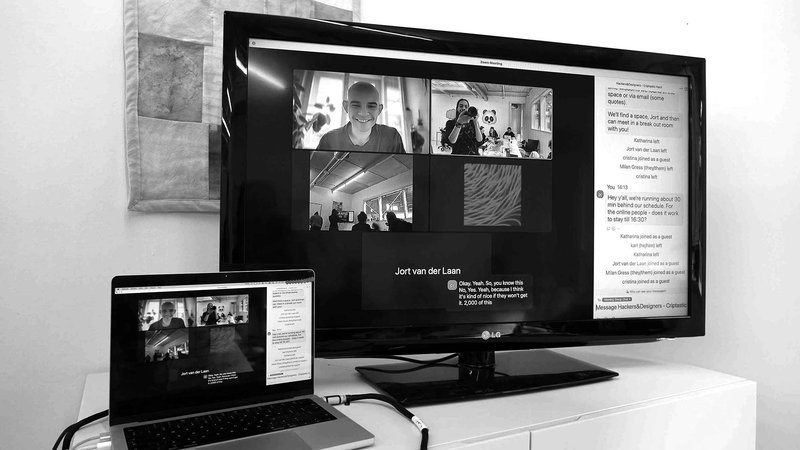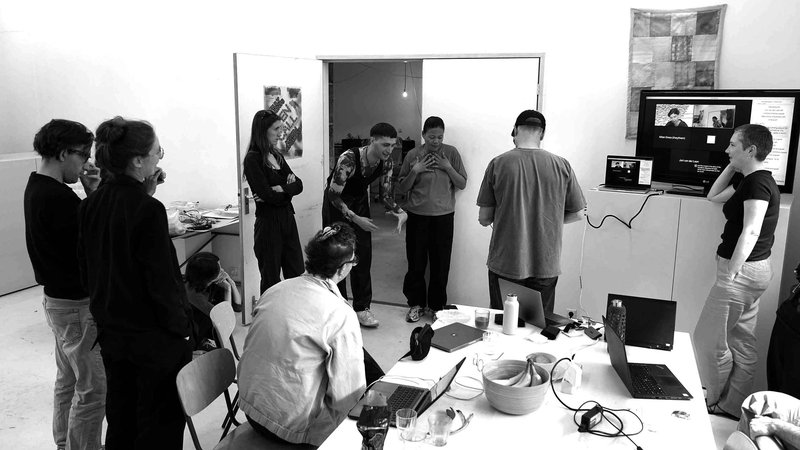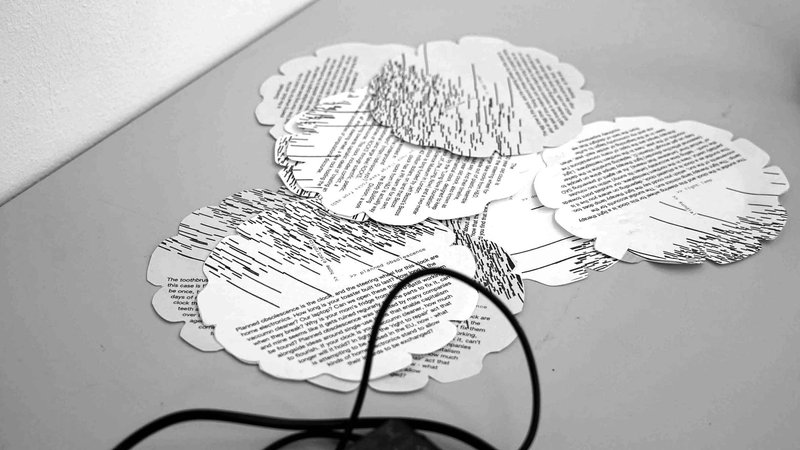chapter
Steering Crip Time
By MELT (Ren Loren Britton & Iz Paehr) and H&D (Pernilla Manjula Philip, Anja Groten, Heerko van der Kooij)
In June of 2024 H&D and MELT (Ren Loren Britton & Iz Paehr) hosted a criptastic hack meeting – a hands-on workshop that brought together MELT’s imaginative and speculative design approach to dreaming up Anti-Ableist technologies with H&D’s hands-on hacking approach to imagining more regenerative and equitable techno-futures.
Inspired by a lineage of crip 1technoscience, the approach to the session was equally practical as imaginative-fictional, resisted tech-solutionism, and aimed to generate energies around multitude conceptions of time2
MELT and H&D worked together on this workshop over the course of several work sessions, getting to know each other in the making process, through engaging in each others research and practices, by spending time together in Berlin, Amsterdam and online, and by sharing and preparing readings for each other. With this contribution we would like to share the workshop script that we developed throughout this exchange, and hope by (re)publishing it will provide collective energies, imaginaries and practices around crip time, and perhaps new workshop iterations can evolve from it in the future.
We invite you to ride the unruly/unexpected/fantastic undercurrents of crip time3 with us and create other collective imaginaries for interfacing with crip time that counter the universalist assumption that all bodies and minds experience time and space similarly.4 Compulsory techno-capitalist paradigms of time-efficiency,5 consistent and seamless labor performance and presumed able-bodiedness pattern time structures that are inaccessible for many people.6, 7 Ren Britton writes: “My bodymind is expected to move quickly, to keep up with turbo-capitalist computational clock time that counts to the millisecond.”8

ID: Pernilla who is in the physical space is making a picture of the online participants
We propose hacking as a way to counter the notion of universal time and tune into crip time.9 Crip time shows that there are other ways of being in time: slow, in attunement with pain or symptoms,10 with JOMO (joy of missing out), in resistance towards capitalisms temporal demands.

ID: Workshop participants presenting their clocks / steering wheels in an enclosed workshop space. There is a screen on the right, where online participants are following. Others are standing around in the physical space following the presentation
We invite you to imagine and protoyped clocks that work against gregorian clock time – clocks that are sensitive to interfacing with crip time. We are also worked with the concept of the ‘steering wheel.’ Such steering wheels let us navigate and attune to different individual and collective temporalities. They help us approach the body as something that is constantly changing, that may go through and stay in states of illness, exhaustion and disability. Steering wheels are something you need in order to interact with/make sense of otherwise timelines.

ID: A pile of worksheets. The worksheet contains the descriptions of the steering wheel components and are cut out in the shape of an imperfect circle.
We invite everyone to engage in a small ritual with us for giving up temporal dependencies. As a start, we ask you to decide upon one timely device that you would usually depend on and that is attached to Gregorian time. This could be your smartphone, smartwatch, regular watch, your morning alarm, a calendar reminder, your social media push notification. You can choose something that you are okay with giving up for the duration of the workshop, however large or small.
The steps are:
1) Place your Greogorian clock/object/entity in front of you.
2) Promise your object that you will pick it up again in the future.
3) Put it into your backpack or somewhere else where you won’t be in touch with it for the next hours. This could also just mean: Closing your email program, or stopping your alarms.
Thank you – We are now ready to dive into the ocean of crip time.
[ Here we take some time to contextualize the notion of crip time and what it means to us. If crip time is a new concept for you, we invite the reader and fellow workshoppers to visit the proposed references in the bibliography to familarize yourselves with crip time. Iz shares that “Crip time exists because many people have expectations about time: How long should something take? What is a normal amount of time? Many disabled people say: Crip time is normal for us. In this workshop we say: For crip time we need new clocks.” ]
Steering wheel and clock components
On a ship on the ocean, steering wheels are used to find a new direction. The steering wheel is how the clock is in operation for the context of this workshop. Some clocks are steering wheels at the same time, others are distinct. Think of your clock and its steering wheel as the what and the how. The clock is the ‘what’ and the steering wheel is the ‘how’. These steering wheels modulate normative time through being slow, by engaging shifting materials, by inventing other temporal patterns, or by incorporating noise/rhythm. They are invitations/portals/ wormholes/custom controllers to interface with the crip time ocean. We invite you to build these otherwise clocks from materials we have brought.
While we do this, let us be mindful of some parts of the oceans where sharks swim – these places we ask you not to visit: For example, please don’t use your steering device / clock to interface with a disability experience that you do not personally have to prevent nondisabled assumptions. We ask you to start from your own experience and how you would interface with the crip time ocean.
We have prepared different materials for you that represent ‘clocks’ (what) and ‘steering wheels’ (how). Those are the components that you can use to start working on your clock, in smaller groups of individually if you prefer.
>> Hourglass + Bucket of sand
The hourglass is the clock, and the steering wheel for this clock is a bucket of sand. As a bucket of sand, broken down from the hardest mountains, crumbling into boulders, slabs, hefty rocks, smaller rocks, pebbles, granules and eventually - sand. The transformations of sand from mountains, hammering away at the disintegration of matter from the literally massive into the particulate. Hourglasses and the sand they hold pose a specific kind of material time, its both the amount of time of the sand moving between one bulbous shape to another, and the holding of what could be seen as mountains, worn down by time, in a small glass bulb.
>> Downloads - Load time
Downloads is the clock, and the steering wheel for this clock is the load time. How long does each download take? Do you need multiple plugins to make that download work? How about updates to the software? How many programs have you had to download to make that one other program work and how long did it take? And how about your trash bin? What about all those installers you had to install… Do you still need them now that the program is downloaded? How long did it take? And could you find that link again if you needed to?
>> Time crystal - crystal oscillator
The crystal oscillator is the clock and the steering wheel are crystals. Crystal oscillators are part of many digital circuits because of its ability to generate a stable pulse and therefore creating a clock signal. With a reputation of being high-precision, this slab-cut power stone is connected to its environment and able to adapt thereafter. Temperature, power supply and other components (neighbors) affects the quart’s rhythm. What changes your rhythm, and how does that affect your dance, your talk, your songs? What/who resonates with your pulse and what set’s its frequency?
>> Toothbrush + toothbrush
The toothbrush is a steering wheel of time that comes regularly. The clock in this case is the same as the instrument. Depending on your habits it might be once, twice, thrice a day - or every other day. Sometimes, after a few days of not engaging the toothbrush, your teeth may feel grimy, as a clock the toothbrush freshens you up, gets into the nooks between teeth and itself needs to be replaced regularly. Toothbrushes, over time, lose their usefulness for teeth and may become agents of cleaning - all of the edges of tiles and corners may be easily cleaned by using a toothbrush and in this way its function changes over time.
>> Sundial - light lamp
The sundial is the clock and this steering wheel for this clock is a light therapy lamp. The light therapy lamp mimics the sun. The sundial accounts for the movements of the sun, which you could say the light therapy lamp does too. The sundial as a clock is a situated clock, depending on where you live it is partially useful. Here in the northern hemisphere, our sundials point towards the north - telling time accurately (when its sunny) within two minutes of ‘actual time’ (whatever that means). As an agent of preventing SAD (seasonal affective disorder) light therapy lamps shine on people to help us get enough Vitamin D, replacing sunshine in the darker months of the year, here in the northern hemisphere.
>> Push notifications - screenshots /screen time
Push notifications is the clock, and the steering wheel for this clock are screenshots/screen time. Just think of all of the notifications of space/place/time/reminders that pop up on your phone. And the reminders of your material connection to screens through the screenshots we take of where we need to be, and how. When and why. And the screen time notifications that tell us how many hours we have labored in front of this screen, daily, weekly and monthly.
>> 10,000 year old clock - rock (large fake rocks from H&D)
The 10,000 year old clock is the clock, and the steering wheel for this clock are the large fake rocks from H&D. These large fake rocks, made out of plastic resemble rocks, cosplay rocks you could say. And their timeline may in fact be similar. The 10,000 year old clock, also known as ‘the clock of the long now’ is a mechanical clock, designed to keep time for 10,000 years. Its being built by the “Long Now Foundation”11 and a two-meter prototype is now on display at the Science Museum in London. The first full-scale prototype of this clock is bing funded by Jeff Bezos’s Bezos Expeditions project, with a budget of 42 million dollars, on land that Bezos owns in Texas. Even though this clock has its own PR team, the history of the large fake rocks from H&D is actually way more interesting. These rocks existed in the Body Building exhibition at TETEM from The Underground Division, a work of theirs titled “Rock Repro”12 - a collection of computational (and large fake) ROCKS, telling unstable stories of ROCKS through scientific, poetic, public and technological discourse. This clock, includes conflict, a 10,000 year old clock moving towards capitalist ideals of ‘creating an iconic clock for all’ and a steering wheel, a fake rock holding the difficulties and possibilities of computational discourse.
>> Egg timer - egg timer
The egg timer is the clock, and the steering wheel for this clock is also an egg timer. Timing around three minutes in gregorian time, this span of time indexes just about how long it takes for an egg’s innards to transform from liquid to soft-medium-or-hard-boiled, depending on how high the altitude is at which you cook. This timer clicks down, and rings like a school bell, loud - and finished - at the end.
>> Planned obsolescence - home electronics
Planned obsolescence is the clock, and the steering wheel for this clock are home electronics. How long is your toaster built to last? How long is the vacuum cleaner? Our laptops? Can we open these things up and fix them when they break? Why is your mom’s fridge from the 70’s still working, and mine seems like it gets ruined regularly and the parts to fix it, can’t be found? Planned obsolescence was invented by many companies alongside ideas around single-use items that enable capitalism to flourish. If your clock is your vacuum cleaner, how much longer will it hold? In light of the ‘right to repair’ act that has been proposed to the European Parliament and Council, now - what kinds of home electronics stand to allow their innards to be exchanged?
>> Watch - Watchy
The watch is the clock, and the steering wheel for this clock is Watchy. Watchy is an e-ink watch with open source hardware and software, a PCB makes up the watch body - and it can be customized with 3D printed cases and watch straps.13 You can upload your own watch face, images and websites to it - and it can sense movement - up, down, sideways, otherways. Watchy can be reprogrammed, and interacted with using the Arduino IDE. Watchy can sense the swinging of our arms when its attached to our wrists or ankles and we can watch our limbs move on a small website that tracks its movement. These movements approximate and yet don’t compile a proper ‘clock’ - after all, what is a clock?
Technical documentation: https://github.com/hackersanddesigners /criptime

ID: A worksheet with input fields for the name, characteristics, components of the clock and one to add a drawing of it. The shape of the worksheet is round with imperfect edges
- “Crip” is a political reclaiming of the derogatory label “cripple.”
- http://meltionary.com/antiableisttech/
- The phrase “crip time” comes from feminist, queer, and disability scholar Alison Kafer and refers to the imperative for a new way of understanding time in a way that acknowledges different lived realities. Alison Kafer, Feminist, Queer, Crip, Indiana University Press, 2013.
- Christine Miserandino, Spoon Theory https://butyoudontlooksick.com/articles/written-by-christine/the-spoon-theory
- Sick Time, Sleepy Time, Crip Time: Against Capitalism's Temporal Bullying https://www.bemiscenter.org/exhibitions/sick-time-sleepy-time-crip-time-against-capitalisms-temporal-bullying
- Trans Temporalities https://euppublishingblog.com/2017/04/27/trans-temporalities/
- In the Meantime: Temporality and Cultural Politics https://www.jstor.org/stable/j.ctv11cw801
- Ren Loren Britton, On Rehearsing Access. Making space for non-normative time with Access Riders. https://futuress.org/stories/rehearsing-access/
- Ellen Samuels "Six Ways of Looking at Crip Time"
- https://overexposed.sonicacts.com/neveroddoreven/map
- https://en.wikipedia.org/wiki/Clock\_of\_the\_Long\_Now
- https://ddivision.xyz/
- https://watchy.sqfmi.com/